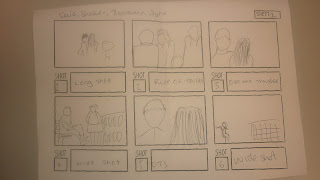We had been given a health and safety tutorial of how to use the JVC camcorders correctly. In this tutorial we were shown how to insert and eject the battery and memory card in and out of the camera. Also, we were taught about the different functions of some of the buttons on the camera. For example, which buttons were used to zoom in and out.
Framing was another aspect of filming that we had learnt in the tutorial. It was important to know how a shot should be framed properly because if a shot was to be recorded incorrectly due to the framing then the shot would be appropiate to use. For example, whilst recording it is important to make sure that there is not too much space left on either side of the subject or above the subject in the shot.
Within this tutorial we were taught how to construct and adjust a tripod carefully, so when the camcorder is placed it would be in a secure position.
Some important rules that must be obeyed whilst using the filming eqiupment is that:
- Never leave any equipment unattended
- Always return all equipment on time
- Do not leave any equipment out in the rain
- Do not touch the lenses or change the settings of the camera
- Overall, take care of all equipment and use it safely


























